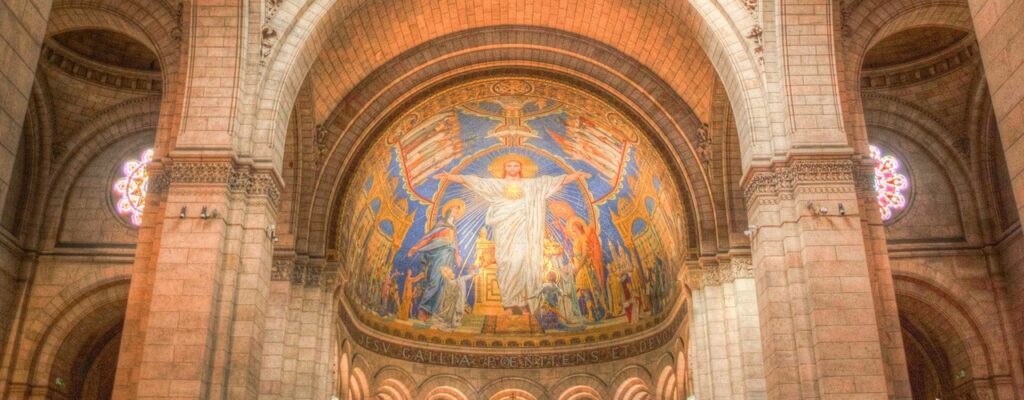
Is God More Than Three Persons?
A Brief Look at Revelation 4:5
by C.M. Hegg
Download this Article in PDF by Clicking Here
Apocalyptic literature is notoriously difficult to understand and interpret. There are far better minds than mine that have undertaken the task of exegeting books like Revelation and since my studies have focused more on Luke/Acts I have been happy to leave the challenge of interpreting such works to the professionals. With this said, my recent studies on the doctrine of the trinity have brought me to some passages that have been interested and downright fun to investigate.
One of the questions that were posed to me within my exploration of trinitarian theology was that of the persons within the Godhead. The question goes like this, “if we can believe that God is three distinct persons in one, why couldn’t we believe there are four persons, seven persons, or as the Jewish kabbalists have preposed, twelve persons in one?” My response to this question has been that the Bible reveals God as Father, Son, and Holy Spirit who are all distinct in person while being one in His eternal nature. Recently, someone challenged me on this with several passages from Revelation that speak of the “seven spirits of God” (ἑπτὰ πνεύματα τοῦ θεοῦ) (Rev. 4:5, 5:6).
Before we look at these passages in depth there are several things that I have noticed. First, this is the first time within the entire Bible that we are faced with the notion of God having seven spirits. Certainly, we accept this book as Scripture, but since we do not have another witness within the entirety of Scripture we need to approach this passage understanding that this is new language and we should make sure to look twice. Second, since we are dealing with apocalyptic literature imagery is often metaphoric. Third, we have parallels to this text within other prophetic books within the Scriptures that we will look at below.
Modern scholarship largely holds to two understandings of what the seven spirits of God are. The first and most popular proposal is that the seven spirits are angelic beings that carry out the will of the Lord. This is based on John’s opening to the book where he states:
John to the seven churches that are in Asia: Grace to you and peace from him who is and who was and who is to come, and from the seven spirits who are before his throne, (Revelation 1.4 ESV)
The seven spirits that are before His throne are (tentatively) interpreted as angelic beings that serve to carry out the Lord’s will.1 Thus, the seven spirits of God in 4:5 are interpreted as the seven angels of God previously mentioned in chapter 1. In the first chapter, John describes the vision of the Son of Man (no doubt a reference to Daniel 7:13) and describes Him as holding seven stars in his hand. In verse 20 this “Son of Man” states:
As for the mystery of the seven stars that you saw in my right hand, and the seven golden lampstands, the seven stars are the angels of the seven churches, and the seven lampstands are the seven churches. (Revelation 1.20)
The figure speaking to John describes the stars as the seven angels of the seven Churches while the golden lampstands are the Churches themselves. The word used in the Greek is the word used in the LXX for the menorah found within the tabernacle. In 4:5 the seven spirits are represented as seven torches, “λαμπάδες” a different word than found in 1:20. Nevertheless, David Aune still believes the imagery in 4:5 is meant to represent the menorah within the temple:
Since the view is frequently found in early Judaism that angels are made of fire, it is possible that seven angelic beings are referred to here (as the allegorical interpretation in v 5c makes clear), or that the seven blazing torches represent the menorah. IIApocBar 21:6 mentions countless beings constituted of flame and fire who stand around the throne of God, and 4 Ezra 8:21–22 speaks of the hosts of angels who stand before God’s throne and at his command are changed to wind and fire. The seven burning torches would most naturally appear to represent the seven-branched menorah before the ark in the tabernacle (Exod 25:31–40; 27:20–21; Lev 24:1–4; Zech 4:2; cf 2 Chr 4:7).2
The interpretation that the seven spirits are angels can certainly be supported by the language of the text since in the Greek “of God” (τοῦ θεοῦ) could be in reference to God’s Spirit, could mean to proceed from God, or could mean “belonging to” God. Thus, we could interpret this passage, “which are the seven spirits [angels] that are owned by God.”
A second view among scholars is that the “seven spirits of God” is, in fact, the Holy Spirit. This view takes on several different perspectives but is one that I find to be the most compelling due to a parallel text in Zech. 4 which states:
And the angel who talked with me came again and woke me, like a man who is awakened out of his sleep. And he said to me, “What do you see?” I said, “I see, and behold, a lampstand all of gold, with a bowl on the top of it, and seven lamps on it, with seven lips on each of the lamps that are on the top of it. And there are two olive trees by it, one on the right of the bowl and the other on its left.” And I said to the angel who talked with me, “What are these, my lord?” Then the angel who talked with me answered and said to me, “Do you not know what these are?” I said, “No, my lord.” Then he said to me, “This is the word of the LORD to Zerubbabel: Not by might, nor by power, but by my Spirit, says the LORD of hosts. (Zechariah 4.1–6)
Scholars such as Aune3 have noted the similarity in the scenes between these two texts. Zechariah 4 specifically states that the lampstands are the Spirit of the Lord (v. 6) thus making the claim that Revelation 4:5 is speaking about the Holy Spirit stronger. But if this is the case why would the Spirit be seen as seven?
One view is that the seven spirits refer to the workings of the Holy Spirit found in Isaiah 11:2. In this passage, we once again have a Messianic text that speaks of the Holy Spirit resting on Yeshua.
And the Spirit of the LORD [1] shall rest upon him, the Spirit of wisdom [2] and understanding [3], the Spirit of counsel [4] and might [5], the Spirit of knowledge [6] and the fear of the LORD [7]. (Isaiah 11.2)
This view assumes that the number seven is to be taken literally, whereas another view put forward by Simon Kistemaker is that the number should not be taken in this way but should, rather, be taken as a sign of completion.
Once again the symbolism of this text is now expressed in the number seven, which occurs twice. It is the number of completeness and fullness. The seven torches represent an abundance of light at God’s throne, and the seven spirits are a representation of the Holy Spirit’s fullness… John has taken his symbolism from the golden lampstand in the tabernacle (Exod. 25:31-40; 27:20-21; 40:24-25; Lev. 24:1-4) and from the prophecy of Zechariah (4:2)… The symbolism of the fullness of God’s Spirit points to the work the Holy Spirit performs in regard to interpreting God’s will, encouraging and comforting his people, sanctifying saints and reproving sinners (see John 16:7-11; Acts 2:17-21)4
Kistermaker’s suggestion is made stronger by the fact that the number 7 is used 55 times within the book of Revelation. Thus, I believe it is persuasive to see this specific reference to 7 (along with v. 5:6) as a sign of completion and not as a literal number 7. What is more, John is describing the Messianic figure, Daniel’s ‘Son of Man’ who is Yeshua, sitting on His throne in glory. It certainly seems possible that the symbol of the completion of the Spirits work and/or the fullness of the Spirit coming to pass at that time would be seen by John.
A suggestion I have not seen but one that came to mind is that the seven spirits of God might actually be the seven Churches spoken of in 1:20. If the Spirit of the Lord is working through and indwelling the believers within God’s ekklesia (Church), and the number 7 is seen as a sign of completion than the seven Churches could represent the full and true-believing community. If this is the case then when God looks at the Church, He would see His Spirit dwelling in them. This would make the seven spirits “belonging to God” the Church itself, something that Christ specifically says the lampstands are in 1:20.
This final suggestion may be something to consider and look at more. For now, I find Kistermaker’s suggestion that the number 7 in v. 4:5 should be seen as a sign of completion and that the Spirit of the Lord has come to its fullness within believers and the throne room of God to be the most compelling. What we can say for sure is that the notion that John is presenting God as being 9 in one (Father, Son and seven spirits) is not something that any commentator that I have looked at has suggested, nor does it seem to be found within the text itself.
Post image by Skitterphoto



